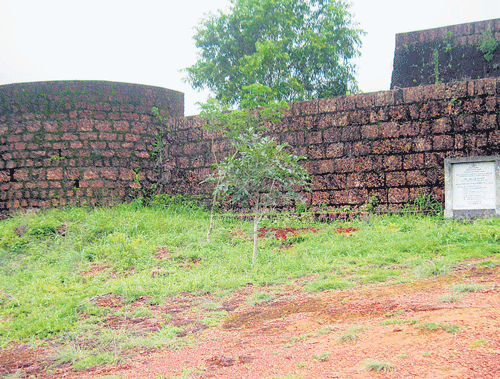
Forts conjure up visions of kings and warriors, bloody battles and conquests, strife and victories and evoke images of a bygone era when all was fair in love and war. Some of them, to this day, stand tall and strong, speaking volumes about the historical events they witnessed.
The twin forts of Bekal and Chandragiri are situated within a distance of five km from each other. They belong to Kasargod district, in the northern most province of Kerala, bordering the Dakshina Kannada district of Karnataka.
The Bekal Fort, preceded by a colourful history of over 300 years, is the largest in the state of Kerala. Perched on a rocky hillock that is130 ft high, encompassing a 35 hectare plot, with its outer wall projecting into the raging Arabian Sea, the fort presents a formidable picture in stone. The outer walls on the northern, eastern and southern sides are at a towering height and have deep moats surrounding them, making them impenetrable.
With the southern part possessing a natural barrier that is the sea, the fortress is an example of a sound defence strategy from the enemy attack. There is a mosque just outside the entrance, probably a stamp of possession of the fort by the Mysore Sultans, and a Hindu Anjaneya temple just within the premises of the fort, surely a testimony of the religious coexistence and tolerance that existed in those days.
Tracing roots
Delving into the history of the fort, we find that Bekal was once a part of the Mahodayapuram Perumal kingdom. The Kondavalam inscription of King Baskara Ravi II found here corroborates the assumption. After their decline came the Kolathiri Rajas, who dominated this region.
With the collapse of the illustrious Vijayanagar Empire, many feudal lords under their reign became independent and the Keladi Nayakas realising the strategic and economic importance of the Tulunadu territory came to rule Bekal and decided to fortify it. The foundation for the fort was laid by Hiriya Venkatappa Nayaka and was completed during the rule of Sivappa Nayaka in 1650 AD.
The Chandragiri Fort too is said to have been constructed during this period. The Kolatheri Rajas, in a prolonged struggle, fought to recover their territories from the Nayakas. Subsequently, the war-weakened Nayakas were conquered by Hyder Ali of the Sultanate of Mysore and Bekal fell into the hands of the Sultans. Bekal served as an important military station of Tipu Sultan. He used Bekal as a base to capture the Malabar region.
Its importance declined after the defeat of Tipu by the British in the Anglo Mysore War in 1799. However, the British further strengthened the southwestern part of the fort against Dutch invasion as they had settled in Kannur and fortified the region with the St Angelo Fort. After Independence, the fort became a part of South Kanara district. Later, with the reorganisation of states, it became a part of Kerala.
The Fort comprises a tank with a flight of stairs, probably a watering hole for the garrisons and horses stationed there. There is a dungeon meant for war prisoners, a magazine for storing ammunition and a secret tunnel leading outside, which may have been an escape route in times of a siege. At the centre of the fort is a magnificent observation tower with a ramp to hoist machine guns up.
The tiny holes on the outer wall of the fort are a marvel in design. The topmost holes were meant for aiming at far off points, holes at the centre for shooting at the enemy and the holes below facilitated attack when the enemy was close at hand. There is a stairway inside the fort leading to the outside, into a circular bastion built on a rocky formation projecting well into the sea.
The Chandragiri Fort, on the other hand, is a square fort, 150 ft above sea level, occupying a seven acre area of land by the side of the estuary of river Payaswini just before it joins the Arabian Sea. Situated on a rock, it is completely unapproachable from all four sides. The northern side facing the river is steep and the slippery river is a natural barrier to the enemy forces. The three other sides have rocks and forests to prevent the smooth march to encroach the fort.
Though the Chandragiri region was initially held by the Kolatheri kings, it was captured by the Vijayanagar empire and looked after by the Keladi Nayaka, the local chieftains under them. With the decline of the Vijayanagar kingdom in the 16th Century, the Nayakas took over and Sivappa Nayaka built a chain of forts, of which Chandragiri was one.
There are four watch towers built to sight the approaching enemy. One can watch the boats gliding down the river, the ships waiting to anchor in the distant horizon and the view of the majestic coconut palms swaying in the gentle sea breeze, the endless stretches of paddy fields covering the landscape from these towers and time just seems to stand still.
In 1992, the Government of India declared Bekal and Chandragiri forts as special tourist zones. Visiting these forts can be a wonderful experience for history buffs, nature lovers or for those who simply want to take a break from monotony.